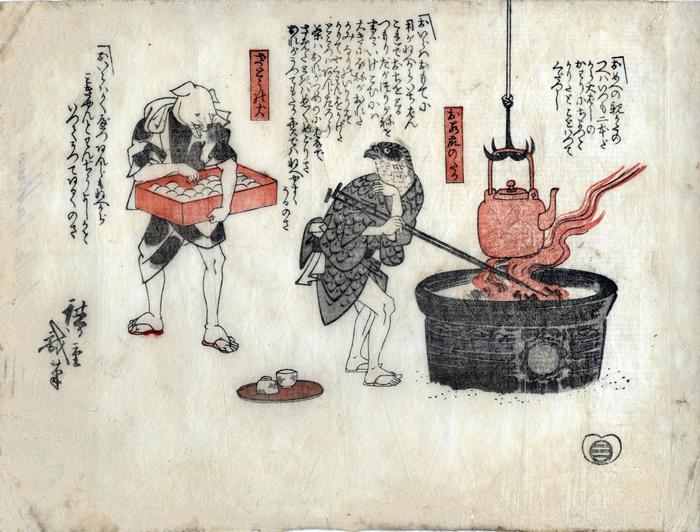Utagawa Hiroshige (歌川広重) (artist 1797 – 1858)
Humorous Hiroshige print with a dog-headed man (Blind Dog, Zatō no inu, ざとうの犬) and bird-headed man (-- Black, -- Kuro, --くろ) preparing a meal
1844 – 1849
11 in x 8.375 in (Overall dimensions) Signed: Hiroshige giga
広重戯画
Publisher: Ibaya Senzaburō (Marks 127 - seal 08-067)
Anything we could say about this print would be pure speculation until we can find someone who can translate the text. Until then, your guess is as good as ours. However, even after we find someone capable of translating the text we might still not be able to fully understand what the cultural references.
From Yayoi Shinoda: "[I am| still unclear. Here is what I have been able to figure out so far. The red cartouches say that the hybrid figures are “Zatō no inu” (Blind Dog) and “Kuro” (Black). The inscriptions are dialogues between the two."Kuro: I borrowed two of your [sticks?] as hibachi (fire chopsticks). I don’t have a business/chore outside. (The inscription says that she is brewing tea and talks about the fireplace and the kettle, but I cannot figure out the details.)
Zatō no inu: I walk [along the street] and holler “manjū (confection)” to sell them. What is the anthropomorphic bird all about? What is the dog-headed creature saying? We don’t know, but we would like to. Is the bird-man heating water or saké to go with the mochi that the dog-man is carrying? Is there an ancient reference to such an allegory? If so, how ancient and what is the source? So many questions.
Modern audiences unfamiliar with the nuances of the English language as it was spoken or used in the 16th century often have difficulty in fully understanding what is taking place in a play by William Shakespeare. For example, the word ‘nice’ at that time does not mean what the word ‘nice’ means today. In fact, it often meant just the opposite. Add to that the lingo of every generation and is it any wonder people have trouble in understanding what others are saying?
Many people will tell you that they have a friend or acquaintance who is either of Japanese descent or studied Japanese or whatever. They think they can go to them to ask them to read something on a Japanese print and then explain it to them. This is not so simple. In fact, it is far from simple. Without a completely thorough knowledge at an expert level they generally won’t be able to make heads or tails of what they are looking at. Without a scholar’s grounding in all of the cultural references found in a print, everything is guesswork. And remember, even great scholars often disagree.
However, what cannot be denied is the genius of this image. We all love a good mystery. Not only is this print incredibly charming, but, knowing that it is from the brush of Hiroshige makes it all the more remarkable. One other issue of note, is that despite our efforts to find other examples of this print, the only one we have come across so far is the one listed in the reference below, but even there there is no commentary. So until we find something credible imagine along with us what the story must be. Fantasy is something which charms all cultures.
****
Illustrated in An Exhibition of Japanese Prints; Images of the Floating World, Barry Davies, 1998, #138, p. 195.
Ibaya Senzaburō (伊場屋仙三郎) (publisher)
comic prints (giga - 戯画 / kyōga - 狂画) (genre)
